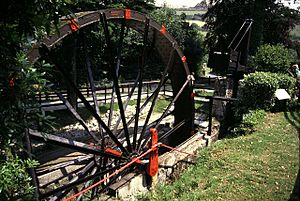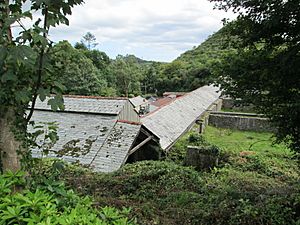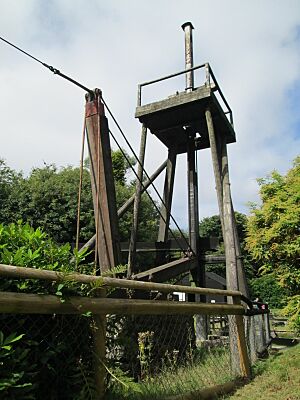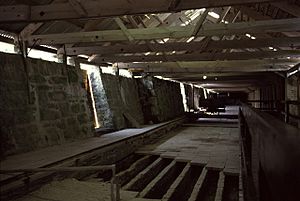Wheal Martyn facts for kids

The 35 ft waterwheel
|
|
| Established | 1975 |
|---|---|
| Location | Carthew, Cornwall grid reference SX 005 555 |
| Type | Open-air museum |
The Wheal Martyn China Clay Museum is a special place in Cornwall, England. It's a museum that shows how china clay was mined and processed. This museum is located near St Austell and lets you explore a real Victorian-era clay works. You can see old buildings, machines, and learn all about this important industry.
Contents
About Wheal Martyn Museum
The museum covers a large area of 26 acres (about 10.5 hectares). It is built around two old china clay factories. Inside, you'll find many old tools, machines, photos, and documents. These items help tell the story of china clay mining.
Wheal Martyn Museum started as a charity in 1975. A charity is an organization that helps people or a cause, rather than making money. In 2010, another charity called South West Lakes Trust took over running the museum. Part of the museum site is a protected historical area. It's also a special scientific site because of its unique rocks and land features.
History of Clay Mining
The story of Wheal Martyn began in 1790 when Richard Martyn bought the land. His son, Elias Martyn, started the Wheal Martyn china clay works in the 1820s. By the 1840s, there were five pits where clay was dug. By 1869, Wheal Martyn was producing 2,000 tons of clay each year!
After Elias died in 1872, his son Richard either closed some works or let other people run them. In the 1880s, John Lovering took over Wheal Martyn. He made many changes to improve the clay works. The main pit at Wheal Martyn closed in 1931. However, the special oven used for drying clay, called a pan kiln, was still used until 1969. It dried clay from other nearby pits.
Another part of the museum site is the Gomm china clay works. The Martyn brothers leased this from the Mount Edgcumbe Estate around 1878. It was used until the 1920s. The Wheal Martyn pit actually reopened in 1971. Today, it is still worked by a company called Imerys Minerals Ltd.
How Clay Was Processed
Mining china clay involved several steps. First, the clay was dug out of the ground. Then, it was mixed with water to create a thick liquid called "slurry." To move this slurry from the pit, a special system was used. A large waterwheel, 35 feet (about 10.7 meters) across, powered a system of iron rods. These rods moved back and forth to pump the slurry. This waterwheel was built in the 1880s and used until about 1940. It was fixed up in 1976 so visitors can see it working.
Another waterwheel, 18 feet (about 5.5 meters) wide, was built around 1902. It powered a "slurry pump" that moved the clay liquid around the site.
After pumping, the clay slurry needed to be thickened and dried. Here's how it happened:
- Settling Pits: The slurry went into large pits with sloped floors. The clay would settle for several days until it was about 12% solid.
- Settling Tanks: Next, the clay moved to settling tanks. Here, it would sit for two to three months, becoming thicker, about 30% solid.
- The Pan Kiln (or "Dry"): This was a large building where the clay was heated from below. Hot gases from coal fires passed under the floor, drying the clay. This process took one to three days, depending on how close the clay was to the fire.
- The Linhay: Right next to the dry was the linhay. This was a storage area where about 1,000 tons of dried clay could be kept. From here, the clay was loaded up and sent to customers.
Transporting the Clay
Moving the heavy china clay was a big job! The museum has examples of the different ways clay was transported:
- A Pecketts railway locomotive from 1899, which used to work at a clay pit in Devon.
- A 19th-century clay wagon, which needed a team of three horses to pull it.
- A 1934 ERF lorry (a type of truck).
- A Peerless lorry from the First World War.
Museum Displays
The museum also has displays that show what life was like for people working in the china clay industry in the 1800s. You can see recreated rooms, like a clay worker's kitchen. There's also a cooper's workshop. A cooper was a person who made wooden barrels or casks. These casks were very important for transporting the best quality clay to customers.




